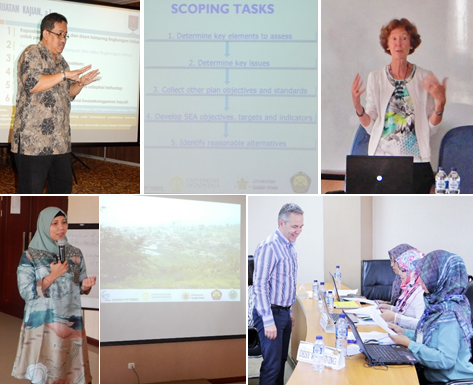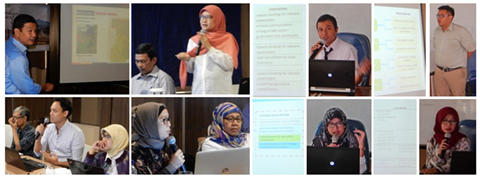INTRODUCTION
In the development of geothermal energy (GTE) potential in Indonesia there are many issues that play a role, and these are not only technical issues. Although the Indonesian Government is strongly supporting the geothermal energy development as one of the clean, renewable and reliable energy supply systems, there is a tension between this policy and policies to protect forests, though both aim to reduce carbon emissions. Up to 42% (some sources mention even 58%) of the nation’s geothermal resources are located in forest areas with a legal status of ‘Protected’ or ‘Conservation’ forest.
Uncontrolled development initiatives can have undesired social, ecological and economic consequences. In GTE development, this continued tension between forest conservation and exploration and between ecosystems functioning and exploitation of reservoirs puts spatial planning under pressure.
According to the Environmental Protection and Management Law No 32/2009, which is strengthened by the Ministry of Environment Decree No 9/2011 regarding the Generic Guidelines of Strategic Environmental Assessment (SEA), every policy, plan and program that may impact environmental and/or social aspects must be subject to SEA in order to ensure sustainable development.
SEA is a mandatory requirement ensuring that sustainable development principles have become a basis of and have been integrated into the development of Policy, Plan and/or Programmes (PPP). The key principles of SEA are (i) the involvement of relevant stakeholders, (ii) a transparent and adaptive planning process, (iii) consideration of alternatives, and (iv) using the best possible information for decision and policymaking.

RELEVANCE FOR AND APPLICABILITY TO INDONESIA
Encouraging provincial and district governments to develop geothermal energy is a big challenge, as expertise and understanding of energy scenarios and energy development is limited. In addition, there is a strong need to bring about much better awareness and acceptance with local populations in areas where exploration and exploitation of geothermal resources is to take place. Another challenge is lack of knowledge and skills to implement SEA as a structural and integral part of planning practice in Indonesia.
SEA should improve both the (spatial) geothermal energy planning process and the information used in this process. Currently the planning process in Indonesia hardly makes use of spatial information. Subsequently there is little attention for the spatial implications of policies and interventions, and the analysis of spatial information is hardly ever used to consider alternatives and cumulative effects.
In European countries, the spatial context plays an indispensable role in the planning process and specific tools and techniques are available to do this. It is therefore considered important to explore how (i) spatial information and Geographic Information Systems (GIS), (ii) Spatial Decision Support Systems (SDSS) that include scenario development and dynamic modelling and (iii) participatory approaches like Participatory GIS (PGIS) can be used to help to identify and structure the problem(s), find and compare possible solutions, and monitor and evaluate the proposed GTE activities.
In this work package, special emphasis was given to these aspects because it will greatly enhance the spatial planning, management and decision-making process for GTE development. Besides that, this work package also aims to analyse existing rules and regulations and develop a SEA training manual for sustainable GTE development that contributes to the harmonization of societal and environmental considerations in the field of geothermal energy.
The long-term objective of work package is to increase the capacity of staff working in the field of SEA for geothermal energy as a tool to gain up to date knowledge and practical skills in SEA for GTE development to enhance sustainable GTE planning and decision-making in Indonesia.
GEOCAP ACTIVITY IN THIS TOPIC
Besides the development of training materials and a SEA training manual for sustainable GTE development, also a stakeholder workshop and training course were organised. The stakeholder workshop took place in May 2016 and the main objectives of the workshop were to i) disseminate SEA on GTE development to stakeholders involved in GTE and ii) get feedback/input/remarks for the training course held in October 2017.
The main aim of the 4 days training course was to increase the SEA implementation capacity in the GTE sector. The topics offered during the training follow the generic steps to be carried out in the implementation of SEA for GTE development, as can be seen in the flyer announcing this training. The participants represented a balanced mix of GTE experts, staff from government institutions, academics and NGO’s.
Overview of main training modules:
1. Introduction in SEA for GTE
What is SEA and how is it conducted worldwide and in Indonesia? This module includes three presentations and one assignment. The first presentation is on SEA in a worldwide perspective and according to international practice. The second one on SEA in Indonesia and the third one on Existing rules & regulations related to SEA for GTE development in Indonesia. As part of the assignment, participants were asked to write down and discuss the main differences between SEA and EIA.
2. GTE policies and plan objectives and screening
What are the main geothermal energy policy, plan and programme objectives and how are they related? When is SEA required? These questions were dealt with in the presentations and a brainstorm exercise.
3. Preparation or SEA Implementation
- Why and What is Strategic Thinking in SEA?
- How to prepare an SEA for GTE Development?
This training session contains presentations and related guided exercises. The first one clarifies the concept of strategic thinking in SEA and the difference with strategic planning. The second one explains what should be considered in preparing a SEA according to the Government regulations on SEA in Indonesia.
4. Scoping
What are the main activities in scoping and who to involve and how? In this session, an introduction into scoping and an overview of its main activities is given (key elements of GTE development, key sustainability issues, other PPP objectives, SEA objectives, targets & indicators, and alternatives & options). Each activity was explained in more detail in separate training sessions, including presentations, videos and guided exercises. Scoping results in the preparation of a scoping report and scoping guidelines.

Figure 67 Participants working in three groups on guided exercises
5. Assessment
After scoping the actual assessment starts, which exists of the following activities: a) compile baseline information, b) organise stakeholder meetings, c) identify, predict and determine the significance of potential impacts, d) mitigate significant impacts, e) set up a monitoring programme, f) compare alternatives and justify preferred alternative(s), g) prepare an environmental assessment report (Environmental Impact Statement, EIS).
It should be noted that in Indonesia scoping and assessment activities are all part of assessment.
What are optimal locations for GTE development? Though GTE is a sustainable energy source, the plant and associated infrastructure can have impacts. As part of the assessment, participants learned how Spatial Multi Criteria Evaluation (SMCE) could be used to establish alternative locations for particularly pipelines and other related GTE infrastructure. Wayang Windu geothermal power plant was used as case study.
6. Recommendation for improvement of the proposed GTE PPP, Quality Assurance and Validation
How to incorporate the results of the assessment into the GTE policy, plan or programme? How good is the SEA? What is its validity? This training session included a presentation on recommendations for improvement of a GTE PPP, quality assurance criteria & its methods and validity criteria & its methods.

Figure 68 Presentations by participants of the stakeholder workshop and the four days training
Materials
CONTACT
- Joan Looijen (University of Twente, ITC)
- Raymond Nijmeijer (University of Twente, ITC)
- Triarko Nurlambang (University of Indonesia)
- Dyah Rahmawati Hizbaron (Universitas Gadjah Mada)

